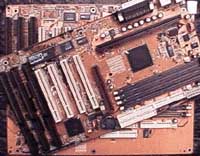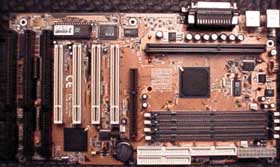Shuttle HOT-637 LX Pentium II Board
by Anand Lal Shimpi on March 24, 1998 10:54 AM EST- Posted in
- Motherboards
With any product there is always room for improvement, with the Shuttle HOT-631 there was a large house full of improvements that could've been made...if you can imagine that list of improvements you can probably imagine Shuttle's newest creation, the HOT-637.
| Socket Style: | Slot - 1 |
| Chipset: | i82440LX |
| Cache: | N/A (On Chip) |
| Form Factor: | ATX |
| BUS Speeds: | 50 / 60 / 66 / 68 / 75 / 83 MHz |
| Clock Multipliers: | 2.0x / 2.5x / 3.0x / 3.5x / 4.0x / 4.5x / 5.0x / 5.5x |
| Voltages Supported: | 1.5v - 3.5v (Auto Detect) |
| RAM Slots: | 4 168pin DIMM Slots (SDRAM) |
| AGP/PCI/ISA Slots: | 1 AGP Slot 4 PCI Slots 3 ISA Slots (1 Shared / 3 Full Length) |
| BIOS: | AWARD PnP BIOS |
| PCI EIDE Controller: | GiG I/O 2 EIDE Channels 1 FDD Channel 2 Serial /1 EPP |
The HOT-631 left a large portion of the PCB (Printed Circuit Board - the actual board part of the motherboard) empty, which although makes the jumpers easy to set due to the lack of a crowded design, it does make the motherboard a bit more pricey than normal. This was the first factor Shuttle improved on with the HOT-637, the 637 is one of the smallest Pentium II motherboards out to date. It is about the length of a FIC PA-2012 and the width of a Baby AT motherboard. This tiny design looks almost as if it were designed for use in a notebook, however don't let the tiny footprint of the HOT-637 fool you, it packs a punch unmatched by any previous Shuttle motherboards. |
 |
The layout of the board is still pretty much the same, 4 PCI, 3 ISA, and 1 AGP slot to cover the majority of computer users. While some prefer the 3 ISA slots of the HOT-637 there are others who would rather have 5 PCI slots. The 4/3/1 design of the HOT-637 will allow you to use an AGP Video card, a Voodoo (or Voodoo2) 3D accelerator, a PCI Ethernet card, and a PCI SCSI card while leaving room for an ISA modem, and an ISA sound card. Don't expect to see more than 7 usable slots on any desktop motherboard, so this is pretty much the best you can get.
| The DIMM slots were brought over from the old 631, unlike the first few LX boards that hit the market, the HOT-637 supports up to 4 EDO or SDRAM DIMMs, which will cover your head if you plan to use 128MB RAM or even more. You don't have to worry about any cacheable memory limit, courtesy of the Pentium II Slot-1 architecture you can cache up to 512MB of RAM using the 512KB of cache on the P2 cartridge. |  |
Classic of all Shuttle motherboards, the HOT-637 is packaged with the Quick Installation Guide, a little card that contains a few decorative stickers, in addition to all the jumper settings necessary to get your system up and running. The Quick Installation Guide documents all the bus speeds available on the HOT-637, including the two overclocked 75 and 83.3MHz bus speed settings. Shuttle even goes as far as to tell you what the PCI Bus Clock will be for each individual Memory Bus setting...not that they think you all don't know how to divide by 2 or anything ;)
In spite of the size of the HOT-637, Shuttle managed to outfit the motherboard with 9 small Sanyo tantalum capacitors, and 7 electrolytic units. The stability of the 637 is a considerable improvement over the old HOT-631, at un-overclocked speeds the board is just as stable as its older brother, however when overclocking, particularly when using the 83MHz bus speed the 637 really begins to shine. Whether you're running at 300MHz or 416MHz the HOT-637 retains the same stability and reliability throughout.
Talking about performance, the HOT-637 is very competitive, although it isn't the absolute fastest at 300MHz, when overclocking it quickly becomes one of the top 5 motherboards reviewed on this page. This is mainly a result of the excellent manufacturing and design that went into the HOT-637, even at the 83.3MHz bus speed setting the memory timings in the BIOS didn't have to be tweaked at all in order to get the motherboard to run Winstone flawlessly. The only other motherboard I've come across that was capable of running reliably at high bus speeds using the most aggressive memory timings in the BIOS setup was the ABIT LX6. Its a shame that the HOT-637 doesn't have a 100MHz bus speed setting, although you don't notice much of a performance difference using the 100MHz bus speed and the Pentium II due to the L2 cache of the Pentium II already running at such a high frequency.
The only downside to the HOT-637 that wasn't given any attention from the earlier HOT-631 was the apparent lack of a Jumperless CPU Setup. Jumperless CPU Setup Utilities seem to be the in-style fashion for most Pentium II motherboards these days, unfortunately Shuttle just hasn't hopped on the bandwagon.
Allows user to individually assign IRQs to PCI/Legacy ISA devices
Allows user to enable/disable USB IRQ
Autodetects PnP Peripherals after POST
| Shuttle HOT-637 Chipset Features Setup | |||
| Item | 66MHz Setting | 75/83MHz Setting | Safe Setting |
| Auto Configuration: | Disabled | Disabled | Disabled |
| MA Wait State: | Fast | Fast | Slow |
| EDO RAS# To CAS# Delay: | 2 | 2 | 3 |
| EDO RAS# Precharge Time: | 3 | 3 | 4 |
| EDO DRAM Read Burst: | x222 | x333 | x333 |
| EDO DRAM Write Burst: | x222 | x333 | x333 |
| DRAM Data Integrity Mode: | Non-ECC | Non-ECC | Non-ECC |
| CPU-To-PCI IDE Posting: | Enabled | Enabled | Enabled |
| System BIOS Cacheable: | Enabled | Enabled | Disabled |
| Video BIOS Cacheable: | Enabled | Enabled | Disabled |
| Video RAM Cacheable: | Enabled | Enabled | Disabled |
| 8 Bit I/O Recovery Time: | 1 | 1 | 2 |
| 16 Bit I/O Recovery Time: | 1 | 1 | 2 |
| Memory Hole At 15M - 16M: | Disabled | Disabled | Disabled |
| Passive Release: | Enabled | Enabled | Disabled |
| Delayed Transaction: | Enabled | Enabled | Disabled |
| AGP Aperture Size (MB): | 64 | 64 | 8 |
| SDRAM RAS-to-CAS Delay: | Fast | Fast | Slow |
| SDRAM RAS Precharge Time: | Fast | Fast | Slow |
| SDRAM CAS latency Time: | 2 | 2 | 3 |
| Spread Spectrum Modulated: | Enabled | Enabled | Enabled |
| Spread Spectrum Modulated: | 1.5% | 1.5% | Disabled |
This little addition to my review layout was put in here just so you all can have an idea of what brand of SDRAM I recommend and have tested with the board, just to avoid problems in the future if you decide to purchase the board.
Recommended SDRAM: Advanced Megatrends SDRAM
SDRAM Tested: 1 x 64MB Advanced Megatrends SDRAM DIMMs
Manufacturer: Advanced Megatrends
Purchase Web-Site: http://www.megacom.com










0 Comments
View All Comments